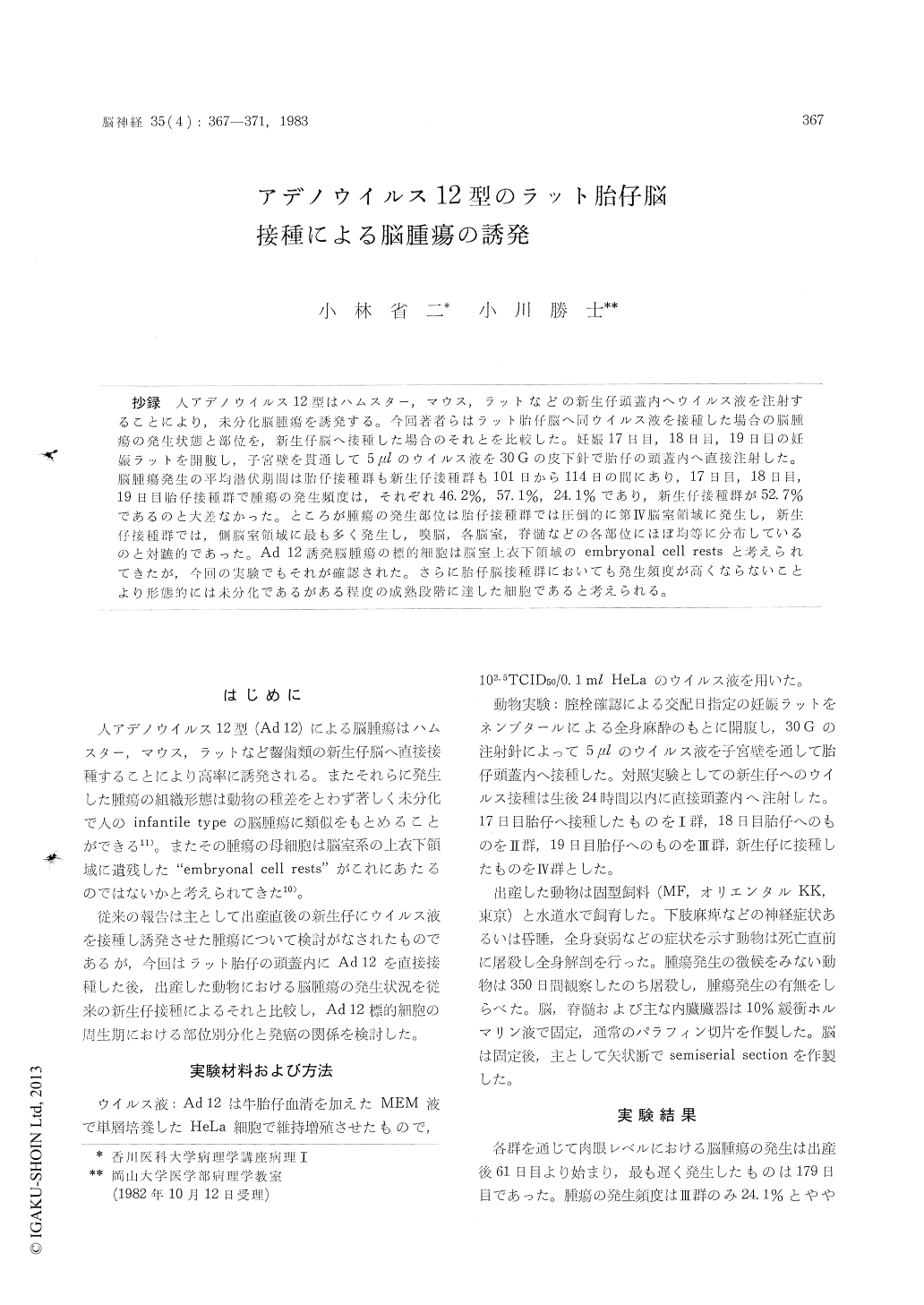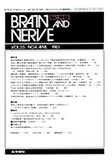Japanese
English
- 有料閲覧
- Abstract 文献概要
- 1ページ目 Look Inside
抄録 人アデノウイルス12型はハムスター,マウス,ラットなどの新生仔頭蓋内へウイルス液を注射することにより,未分化脳腫瘍を誘発する。今回著者らはラット胎仔脳へ同ウイルス液を接種した場合の脳腫瘍の発生状態と部位を,新生仔脳へ接種した場合のそれとを比較した。妊娠17日目,18日目,19日目の妊娠ラットを開腹し,子宮壁を貫通して5μlのウイルス液を30Gの皮下針で胎仔の頭蓋内へ直接注射した。脳腫瘍発生の平均潜伏期間は胎仔接種群も新生仔接種群も101日から114日の間にあり,17日目,18日目,19日目胎仔接種群で腫瘍の発生頻度は,それぞれ46.2%,57.1%,24.1%であり,新生仔接種群が52.7%であるのと大差なかった。ところが腫瘍の発生部位は胎仔接種群では圧倒的に第IV脳室領域に発生し,新生仔接種群では,側脳室領域に最も多く発生し,嗅脳,各脳室,脊髄などの各部位にほぼ均等に分布しているのと対蹠的であった。Ad 12誘発脳腫瘍の標的細胞は脳室上衣下領域のembryonal ceii restsと考えられてきたが,今回の実験でもそれが確認された。さらに胎仔脳接種群においても発生頻度が高くならないことより形態的には未分化であるがある程度の成熟段階に達した細胞であると考えられる。
Human adenovirus type 12 (Ad 12) induces an infantile type of poorly differentiated brain tumor in hamsters, mice and rats when virus fluid isinjected into the newborn.
In this experiment, virus fluid was injected into fetal rat brains and its tumorigenicity in fetal and newborn brains compared. Pregnant rats were anesthesized by pentobarbital sodium on the 17th (group I), 18th (group II) or 19th (group III) day, and 5μl of virus fluid (102.5 TCID50/0.1 ml HeLa cells) was injected into the brain of each fetus with a 30 G hypodermic need-le through the uterine wall. As a control ex-periment, the same dose of virus fluid was in-jected into the newborn brain during the first 24 hours after birth (group IV).
The average latency period for tumor induction in the fetal and newborn groups was from 101 to 114 days. The tumor incidence in groups I, II, and III was 46.2%, 57. 1% and 24. 1% respect-ively, and was 52.7% in the newborn group. Over 65% of the brain tumors in the fetal-injected group appeared in the Nth ventricular area, in contrast to the fact that 46% of the neonatal-injected group appeared in the lateral ventricular area and other tumors were distri-buted in the olfactory, IIIrd ventricular and IVth ventricular areas and in the spinal cord. The tumors that developed in the fetal-injected group were indentical morphologically to these of the neonatal-injected group. All tumors were closely related to the ventricular wall in its origin, and it is interesting that the primary focus of all Nth ventricular tumors was the ventral wall of the ventricle.
It has been proposed that the target cells of Ad 12 are embryonal cell rests in the subepen-dymal layer. This was confirmed by the present experiment. As the tumor incidence in the fetal-injected group was no higher than that of the neonatal-injected group, it is obvious that the target cells are immature in appearence but with some maturation in character. Ad 12 induced brain tumors have some similarities to human medulloblastoma but the most frequent site of development is the opposite side of the ventricle, namely the anterior or posterior vellum.

Copyright © 1983, Igaku-Shoin Ltd. All rights reserved.


